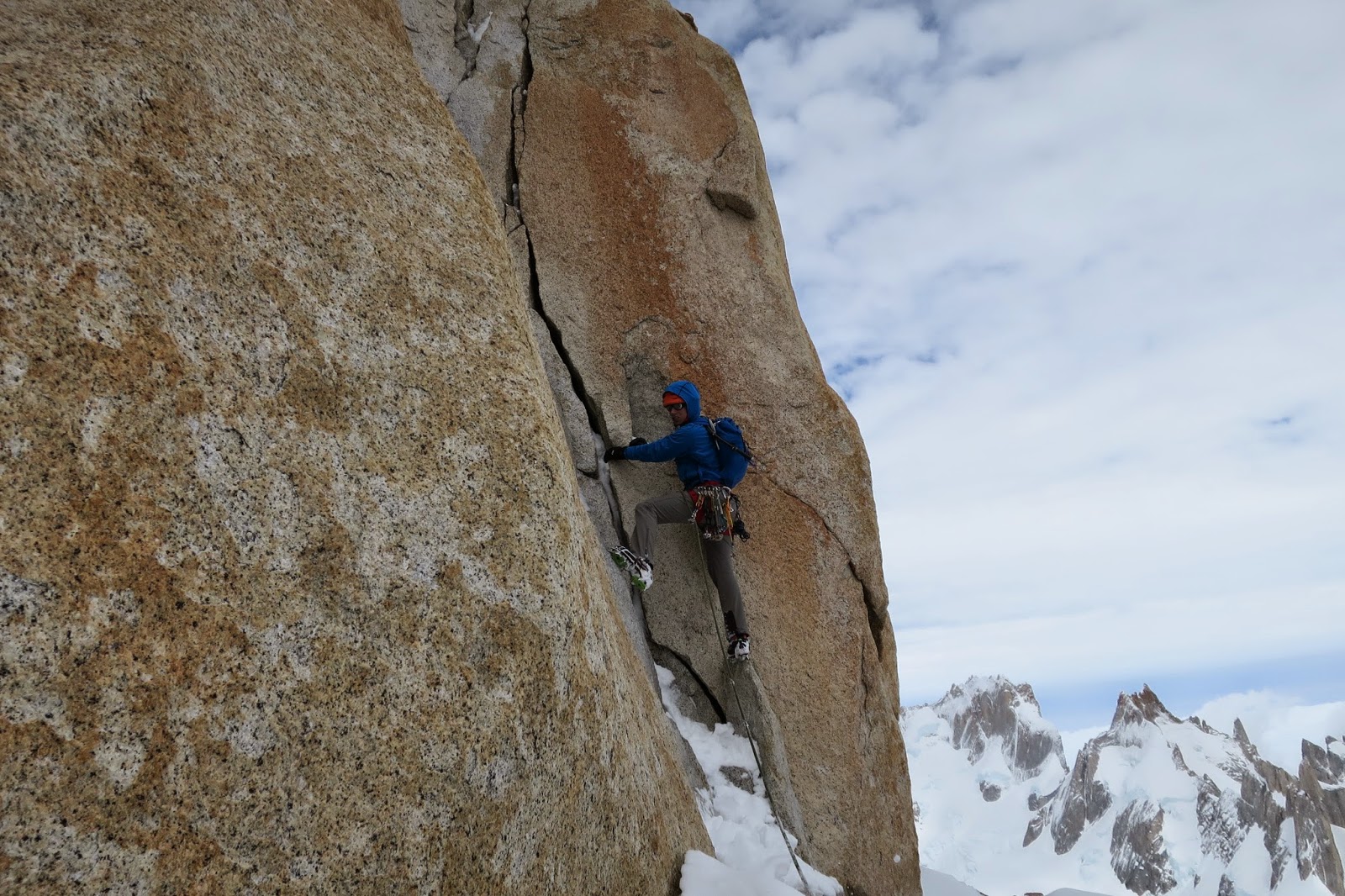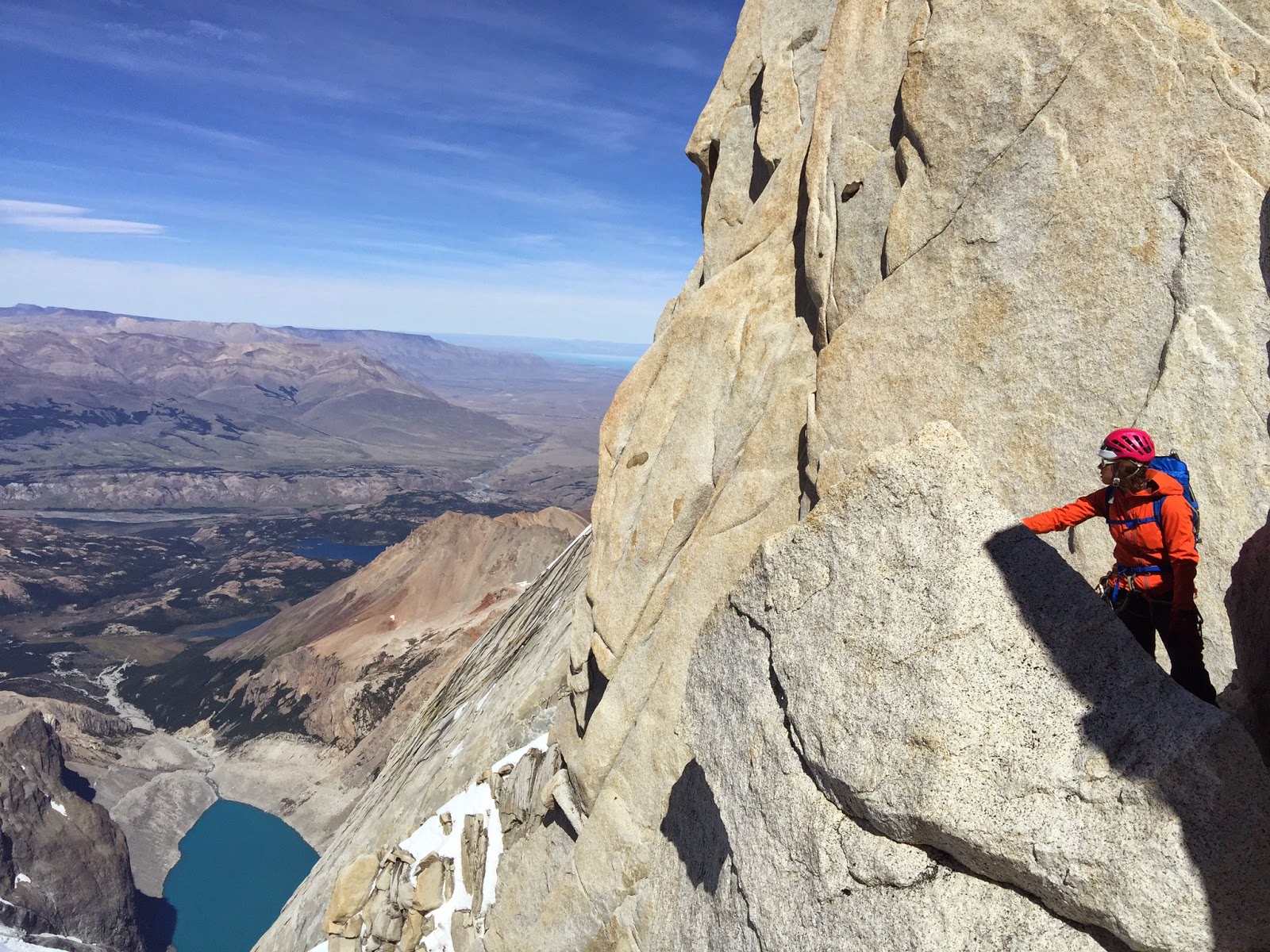 |
| View of Aguja Guillemet with Mermoz and Fitz Roy in the background |
Our first window arrived and we excitedly packed up our gear to head into the mountains. With over a meter and a half of new snow, we were skeptical about rock climbing conditions and concerned about avalanches. Considering all this, we knew our options might be limited.
With alpine climbing, its important to be open-minded, adaptable and flexible as conditions can change rapidly. I tend to like to stick to my plans and can be very goal-driven in terms of my climbing objectives. Prior to this trip, Jonathon asked me to try to be more flexible. With that request in mind, I tried to work on not getting suckered into a single objective and be willing to deviate from our plans.
We hiked up to Piedra Negra in a light drizzle and heavy fog. We were hopeful that the forecast was going to be accurate and the skies would clear later that afternoon. The hike was steep and slippery but not overly eventful. Camp was snowy and the clouds were thick, preventing us from seeing any of our climbing objectives.
 |
| Jonathon hiking through the fog to Piedra Negra |
 |
| Setting up camp at Piedra Negra as the sun starts to warm things up |
We woke at 4 am the next day and began hiking up towards to Comesana-Fonrouge, a moderate rock climbing objective described as the perfect first patagonia route. When we got to the base of the route, we decided that the route was too icy and snowy for us. We turned around and started heading towards Guillaumet Pass to attempt the Amy Couliour. Many other folks had the same idea and we climbed the route with several other parties. There was lots of ice coming down the initial steep snow/ice pitches and my hand got really bruised by falling ice. Those pitches were pretty straightforward and they would have gone much faster if we weren't so concerned about falling ice from the parties above us.
 |
| Hiking towards the Comesana-Fonrouge before turning around |
 |
| Jonathon finishing up the final snow/ice section on the Amy Couloir |
 |
| Checking out the views |
Once we got on the rocky ridge that lead to the summit, we thought we were close to finishing the climb. But because of all the snow, the climbing was more challenging and took some time to keep it safe. We climbed the remainder of the ridge in our boots, while cleaning out ice from the cracks. It felt very alpine-esq and once on the summit we felt that we had earned our summit of this 'easy' Patagonian Peak. The views of Fitz Roy, Cerro Torre and the Patagonian ice cap were spectacular and it felt great to stand on top of a peak.
 |
| Following easy terrain low on the rocky ridge of the Amy Coulior |
 |
| Jonathon leading up the first part of the rocky ridge on the Amy Coulior |
 |
| Leading out up high on the Amy Coulior |
 |
| Jonathon following an icy crack up high on the Amy Coulior |
 |
| My happy place |
After we took a couple summit shots, we started to make our way down the summit snowfield. We ran into our German friends who told us to be careful because the summit sloped had slid and avalanched. This was especially eerie because prior to heading up the slope, Jonathon was very concerned that it was going to avalanche as there was lots of new snow and the heat had been on it for a bit. Fortunately no one was hurt and it was just an abrupt reminder that the mountains are the boss.
 |
| Summit! |
The rappels were straight forward and before we knew it we were back at camp resting our legs and eating dehydrated dinners.
 |
| Rappelling off the upper ridge |
 |
| Patagonia style rappel anchor |
 |
| Hiking back to camp off Guillaumet Pass |
We rested in camp the next day and made plans to check out the Argentina route on Memoz the following day. However, we were defeated by the snow covered slabs that lead to the base of the climb. Worried that these slabs would slide out similar to a pocket glacier once the sun hit, made us concerned about the descent. And with a deteriorating forecast and no knowledge about the alternate descent, we decided to turn around and head back to camp.
And that was it for this weather window. And so we packed up camp, hiked down the big hill and headed back to town.
 |
| Jonathon taking one last look as we hike back to town |
 |
| Jonathon hiking through the wildflowers |

























